
Fundraising
Word Document: Fundraising Flyers
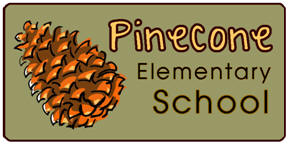 The 6th graders at Pinecone Elementary School are attending High Trails Outdoor Science School from February 21st through 24th. Right now there are 100 enrolled students in 3 classrooms, and everyone will be invited to attend. Although Pinecone Elementary has attended outdoor education events like High Trails in the past, this year all three school teachers are brand new to the grade level and need some help. Here’s how they made it happen.
The 6th graders at Pinecone Elementary School are attending High Trails Outdoor Science School from February 21st through 24th. Right now there are 100 enrolled students in 3 classrooms, and everyone will be invited to attend. Although Pinecone Elementary has attended outdoor education events like High Trails in the past, this year all three school teachers are brand new to the grade level and need some help. Here’s how they made it happen.
May/June
Organize Your Teaching Team
Once they know who the teaching team for next year is, the three teachers sit down to plan.
- Teacher One volunteers to be the contact person for High Trails; this is the person who will plan out details for the trip like classes to choose, groups of students, and student paperwork.
- Teacher Two takes on the management of the money and fundraising.
- Teacher Three agrees to act as support for both of the other teachers.
 Figure out who your teaching team is, and have an honest conversation acknowledging the necessity of working together to accomplish the goal of attending High Trails. Be clear in your job assignments and frank about what you can do and where you will need help.
Figure out who your teaching team is, and have an honest conversation acknowledging the necessity of working together to accomplish the goal of attending High Trails. Be clear in your job assignments and frank about what you can do and where you will need help.
The Money Game
During the first meeting, the teachers discuss fundraising and money collection. They check with their principal and school secretary for details on limitations and procedures.
Total Cost
First the teachers need to determine how much total money they need to raise for their field trip. All of their 100 students will be invited; though they may not all attend, the teachers still base their financial plans on a full house. In addition to the cost of the High Trails program, Pinecone will need transportation for their students; a quick call to several bus companies gives a rough estimate and the teachers use this total amount to come up with a per student amount. Adding the High Trails cost to the transportation cost gives a total per student amount.
 High Trails per student cost = $200 Transportation cost per student = $30 Total cost per student = $230 Total amount of program for 100 students = $23,000 Total / Per Student amounts = $23,000 / $230.
High Trails per student cost = $200 Transportation cost per student = $30 Total cost per student = $230 Total amount of program for 100 students = $23,000 Total / Per Student amounts = $23,000 / $230.
Now that the teachers know the dollar amounts, the Pinecone teachers start referring to their goals as Total / Per Student amounts. Using this kind of reference helps everyone to understand the total goal amount for all students, and, more importantly, the individual amount that it will cost for each student.
 Busses and Transportation: shop around with busses; you have a choice and there are quite a few companies out there. Don’t automatically assume that the price your district charges you is the best deal for your students. There’s also a significant difference in the price between a school type yellow bus and a luxury coach bus, and many transportation companies offer both choices (your school district is not the only one that drives around school busses…). Many schools come to High Trails in the standard yellow type school bus and they work just fine.
Busses and Transportation: shop around with busses; you have a choice and there are quite a few companies out there. Don’t automatically assume that the price your district charges you is the best deal for your students. There’s also a significant difference in the price between a school type yellow bus and a luxury coach bus, and many transportation companies offer both choices (your school district is not the only one that drives around school busses…). Many schools come to High Trails in the standard yellow type school bus and they work just fine.

Also, consider luggage and the space it requires when you price out busses. Some schools bring up a luggage truck for everyone’s luggage. If you do bring a luggage truck, consider renting a U-Haul truck and having a teacher drive it up on the first day. Even if it stays at High Trails all week, the cost for this is considerably less than hiring a truck and driver by themselves.
How To Raise Money
Now that the teachers know what their goal is, it’s time to figure out how to raise the money. The three main ways to raise money are through Voluntary Donations, Voluntary Fundraising, and Grants.
- Voluntary Donations: this is money that comes directly from the parents of students attending High Trails. The teachers know that they cannot ask parents for money; they can, however, let the parents know of their overall goal and how this breaks down for each student. Parents will be told that they can voluntarily donate money towards the overall goal. Any money not raised by voluntary donations will be covered by Fundraising.
- Voluntary Fundraising: in order to raise the funding in time for Outdoor School, the teachers take this opportunity to list some of the many options out there: candy/cookie sale, recycling drive, auction/raffle, donation plan, catalog sale, read/jog a thon, school gear sale, and a car wash.With so many options, the teachers narrow it down and choose two long term and two-short term projects. For long term fundraisers, they like the idea of recycling as it fits with the lessons at High Trails. They will also start a donation plan with the beginning of the school year; this they will call $5 Fridays. One of the short term fundraisers will be a Gift Card Raffle with students selling tickets.As the final short term fundraiser, the teachers decide to compose a sponsor letter to local businesses. These letters offer free advertising on student Tshirts in return for corporate donations to the High Trails trip. The teachers are hoping this will bring in a great deal of funding and form a relationship with businesses for years to come.
-
- Long Term Fundraiser: Recycling
- Long Term Fundraiser: $5 Fridays
- Short Term Fundraiser: Gift Card Raffle
- Short Term Fundraiser: Local Business Sponsors
- Grants: the teachers realize they might be too late for this trip, but they still hop on the Internet to get ideas and apply for what they can. The deadline for the Captain Planet grant is too soon, so the teachers decide to try for the other two this year. Teacher Three volunteers to apply for the grants in June to lessen the load on the team. Here were a couple of their options: Captain Planet, NEA Student Achievement Grant .
 Pinecone decides to set some of their own private goals for how much money is raised in each of the above categories. This will help them immensely as they work towards fundraising in the next several months. 50% will come from Voluntary Donations: $11,500 25% will come from Voluntary Fundraisers: $5,750 25% will come from Grants: $5,750 If the teachers can push through on the Voluntary Fundraisers and Grants it will greatly reduce the per student amount needed, all the way down to $115. This would make Voluntary Donations that much easier to collect.
Pinecone decides to set some of their own private goals for how much money is raised in each of the above categories. This will help them immensely as they work towards fundraising in the next several months. 50% will come from Voluntary Donations: $11,500 25% will come from Voluntary Fundraisers: $5,750 25% will come from Grants: $5,750 If the teachers can push through on the Voluntary Fundraisers and Grants it will greatly reduce the per student amount needed, all the way down to $115. This would make Voluntary Donations that much easier to collect.
Laws about School Fees
 Recent legislation is forcing us to rethink how schools pay for “extra” educational activities. Here’s an excerpt from the proposed CA Assembly Bill 165: “This bill would prohibit a pupil enrolled in a public school from being required to pay a pupil fee, as defined, for participation in an educational activity, as defined, as specified”. NOTE: this law was vetoed by CA Governor Brown on 10/8/2011. As a result, CA AB165 is not in effect.
Recent legislation is forcing us to rethink how schools pay for “extra” educational activities. Here’s an excerpt from the proposed CA Assembly Bill 165: “This bill would prohibit a pupil enrolled in a public school from being required to pay a pupil fee, as defined, for participation in an educational activity, as defined, as specified”. NOTE: this law was vetoed by CA Governor Brown on 10/8/2011. As a result, CA AB165 is not in effect.
CA Education Code 35335: While CA AB165 was vetoed, you do need to be aware of CA Ed Code 35335. This education code has been around for more than a decade. It states: “The governing board of any elementary, high, or unified school district may charge a fee for school camp programs, provided that payment of such fee is not mandatory. No pupil shall be denied the opportunity to participate in a school camp program because of nonpayment of the fee. The amount of the fee may not exceed the difference between any state, local, or federal funds generated by such a program and the cost of the services actually provided. For purposes of this section a school camp program is one which is operated pursuant to Article 5 (commencing with Section 8760) of Chapter 4 of Part 6.”
How does this affect Outdoor Education? Legally, you CAN charge a FEE for outdoor education. However, if a student cannot pay for the experience, you must find a way to come up with the funds to pay for their experience. If you, the student, and the parents really want to make it happen, there is a way: voluntary donations and fundraisers. Here’s an example of a proper way to raise money for your Outdoor Education experience: “The sixth graders from our elementary school will be attending High Trails Outdoor Science School for a 5 day field trip. For all of our students to participate, we need to raise $ _____; this comes out to $ _____ per student. To pay for this experience, our elementary school will be fundraising and accepting voluntary donations. Our deadline to raise this amount of money is _____. If we meet our goal all students will be eligible to attend High Trails. If we do not meet our goal all voluntary donations will be returned to the parents and fundraiser amounts will be used for future student educational activities.”
The glass half full tells us that this vetoed CA Assembly Bill (which is really just a reinforcement of the Hartzell ruling in 1980) truly forces us to look at who gets to experience the wonder and beauty of nature during an Outdoor Science School field trip. It should never be who; it should be all.
Our suggestion is to be upfront and honest with parents.
Incoming Students
Pinecone’s school year ends in mid-June, but the teachers want to get their future students thinking about Outdoor Science School now so that they have some momentum when school starts back up in August. The best way to do this is by working with the 5th grade teachers both in the classroom and at the end of school year Open House.
5th Grade Classrooms
The 6th grade teachers talk with the 5th grade teachers and ask them to help out a bit. The 5th grade teachers are asked to show a short video in their classroom; the best one is the High Trails “Student” video. The 5th grade teachers pass out a 1/2 page flyer announcing the dates of next year’s field trip.
Open House
Pinecone is attending Outdoor Science School next spring, so they decide to wait until the Fall Back to School Night to have a large Parent Presentation. If their field trip was in the fall, they would use the end of school year Open House to talk with parents on a mass scale. Instead, they decide to use the end of school year Open House night to have individual classrooms show videos and hand out information on Outdoor Science School. The 6th grade teachers talk with the 5th grade teachers again and ask for their help; will they show videos during the Open House? The 6th grade teachers each make an informational sign out of large posterboard to place by the TV playing the videos. It has basic information such as who, what, where, when, and costs. They make sure that there are copies of the above flyer available as well.
What Videos?
August
Back To School Night
Pinecone Elementary’s start date is in the middle of August, and their Back to School Night is the second week of school. This is the best time to talk to parents and get them firmly involved in helping get their students up to High Trails. The teachers set a time for an official Parent Presentation and reserve the multipurpose room and a large TV to play videos. A short 15 minute outline for the presentation is written, and the teachers talk to High Trails about the best videos to show.
The teachers send home a flyer announcing Back to School Night and encouraging parents to come and see the details of their field trip. Everyday, as time gets closer, the teachers remind students to get their parents to come to Back to School Night. They figure that the more they mention High Trails in the classroom, the more it will get mentioned at home, and the more likely the parents will help with the cause.
Parent Information: Outdoor Science School
The teachers put together a flyer entitled “Field Trip: Outdoor Science School”. This has all of the details, dates, financial goals for the field trip, and the ways to make it happen. They have this flyer ready to hand out at Back to School Night.
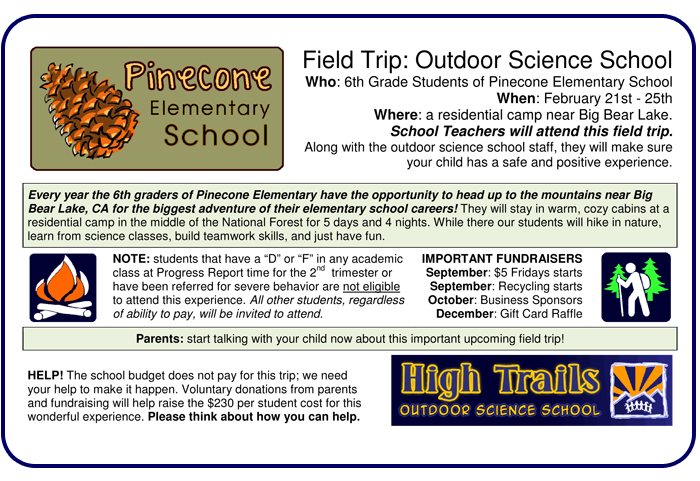
In Classroom Information
Not all of the parents will attend the Parent Presentation, so the teachers have a backup plan; they have small TV’s or computers in their classroom playing videos and parent flyers ready to hand out. The teachers encourage the parents to “check out the information on our field trip and help their child to attend”. They also have a clipboard with a sign up sheet next to the flyers, asking for parents to sign up if they can assist with organization or fundraising for the field trip.
Parent Presentation
- Background Video: while parents are coming in and sitting down, play the High Trails “Site Tour” video. The volume is kept low and gives parents good background information on where their students are going.
- Introduction: the teachers introduce themselves and explain to the parents that they’re going to be talking about their upcoming field trip.
- Who: all of the sixth grade students at Pinecone Elementary, given that they have good grades and behavior.
- What: students will be attending High Trails Outdoor Science School. The teachers play the 3 minute video “Schools and Parents”.
- Where: High Trails is located 30 minutes outside of Big Bear Lake, and is in the middle of the National Forest. The teachers refer parents to the “Site Tour” video.
- Why: the teachers explain to the parents why they believe this is an important experience for students.
- How: the teachers pass out the flyer “Field Trip: Outdoor Science School” and use this for some talking points. They especially emphasize the need for voluntary donations and help with fundraisers. Encourage the parents to come speak with the teachers afterwards if they can help with any of the fundraisers.
- Resources: the teachers encourage the parents to visit the High Trails website. It has plenty of information; weather, webcams, lots of videos, forms, and contact information for the school.
- Question and Answer Session: the teachers open the floor up to questions and answers from parents.
- Close: the teachers thank the parents for their time and encourage them to contact the school teachers or High Trails with more questions. As the parents start to leave, the “Site Tour” and “Students” videos are playing on the TV.
 Pump It Up! Historically, the schools that are the most successful in Outdoor Science School fundraising and attendance are the ones who consistently talk about the experience and get their students excited. Energy is contagious!
Pump It Up! Historically, the schools that are the most successful in Outdoor Science School fundraising and attendance are the ones who consistently talk about the experience and get their students excited. Energy is contagious!
 Get Help from Parents: don’t underestimate the importance of parent volunteers. Get several good parents to help you with fundraising and organization and your job will be much easier. Pass around a clipboard during the Parent Presentation and get phone numbers and email addresses.
Get Help from Parents: don’t underestimate the importance of parent volunteers. Get several good parents to help you with fundraising and organization and your job will be much easier. Pass around a clipboard during the Parent Presentation and get phone numbers and email addresses.
September
Collecting Money
Before the money starts coming in, the teachers consult the school’s office manager to determine the best process for money collection and deposits at the elementary school. Teacher Two (the one in charge of fundraising) receives a receipt booklet and deposit slips from the office. All money collected must be kept in a locked cabinet (desk drawer) during the day and dropped with a deposit slip into the school safe by the end of the school day.
Students and parents are directed to bring all money directly to Teacher Two and no one else. This simplifies the process and frees the other teachers up to work on different projects. Teacher Two collects donations from students and parents, logs them, and hands out receipts. Though there are still five months until it’s field trip time, the teachers are ready for parent donations now.
 Individual Field Trip Fund: each student should have their money and donations logged into their own individual Field Trip Fund. Technically all of the money will be pooled together at the end, but you should still be able to tell each student the status of their Field Trip Fund to help with fundraising goal setting. Another reason to keep track of individual amounts; if everything fails and you cannot attend your field trip, all of the individual voluntary donations should be refunded to the individual student.
Individual Field Trip Fund: each student should have their money and donations logged into their own individual Field Trip Fund. Technically all of the money will be pooled together at the end, but you should still be able to tell each student the status of their Field Trip Fund to help with fundraising goal setting. Another reason to keep track of individual amounts; if everything fails and you cannot attend your field trip, all of the individual voluntary donations should be refunded to the individual student.
 Log like grades: rather than reinvent the wheel, consider logging donations in the same manner that you do grades. Have a log sheet for each class with alphabetized names and write down amounts as they are brought in. Be certain to keep the log sheet on a computer and back it up periodically, or if you have it on paper keep it locked and safe (and make copies every once in a while).
Log like grades: rather than reinvent the wheel, consider logging donations in the same manner that you do grades. Have a log sheet for each class with alphabetized names and write down amounts as they are brought in. Be certain to keep the log sheet on a computer and back it up periodically, or if you have it on paper keep it locked and safe (and make copies every once in a while).
Long Term Fundraiser: $5 Fridays
Once the first few weeks of school for the year are under their belt, the teachers are ready to start the fundraisers. Start early, be consistent, and get parents to help. First stop: $5 Fridays. A small donation every week; this is the concept behind $5 Fridays. The teachers feel that if they can help students and families save for their field trip ahead of time, the money will accumulate quickly and teach students a lesson in savings at the same time. $5 Fridays are a way to spread a large sum of money over a long period, lessening the financial strain on the average family.
- Who’s in Charge? $5 Fridays are a relatively low effort fundraiser. There is no large event and few people to organize. The teachers all agree that they will remind students of $5 Fridays every week and encourage them to save for their field trip. Teacher Two will technically be in charge of this fundraiser because she is collecting the money.
- Announcements to Parents and Students: have each teacher talk about $5 Fridays in their classroom to introduce the fundraiser. Hand out the Fundraiser: $5 Fridays flyer for students to take home to their parents.
- Make Receipts: each time a student brings in money, Teacher Two will give them a receipt. Knowing that she won’t have enough time in the before and after school periods, she prepares receipts ahead of time so all that is needed is a student’s name.

Pinecone starts $5 Fridays the first week of September, and the teachers push it every week through the December holidays. With 12 Fridays, each student has the potential of bringing in, and saving, $70 towards the Outdoor Science School goal. Pinecone makes it to December with about 80% of the students saving the full amount. This puts them at $5,600 towards their goal!
 Twitter and Facebook: consider using this social media network for a truly useful purpose – keeping parents updated on school events instantaneously. It might take you 30 minutes to figure out how to set up an account, but once it’s ready all you have to do is tell your students and parents to follow you and give them your account name. At the end of the school day when you want to send out a message, hop online and type a quick messages and hit enter; it can go to their email accounts or to their cell phone as a text message. You’ll still have to send out flyers and call parents, but every little bit helps. “Don’t forget; tomorrow is $5 Fridays. Will you help your student save money for their field trip?”
Twitter and Facebook: consider using this social media network for a truly useful purpose – keeping parents updated on school events instantaneously. It might take you 30 minutes to figure out how to set up an account, but once it’s ready all you have to do is tell your students and parents to follow you and give them your account name. At the end of the school day when you want to send out a message, hop online and type a quick messages and hit enter; it can go to their email accounts or to their cell phone as a text message. You’ll still have to send out flyers and call parents, but every little bit helps. “Don’t forget; tomorrow is $5 Fridays. Will you help your student save money for their field trip?”
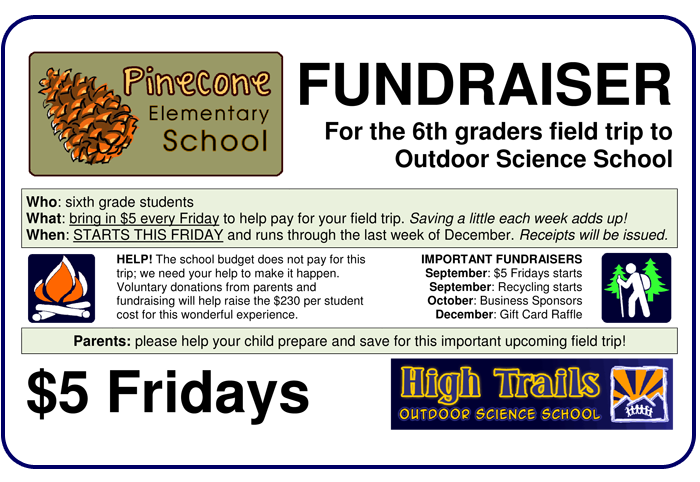
Long Term Fundraiser: Recycling
The teachers heard about this great program from another school that has been using it successfully for many years. Once a month all the students and parents bring their recycling in from home and parent volunteers bag it up and take it off to the recycling center. From here the money goes into the field trip bank account. Recycling consists largely of plastic, glass, and aluminum. This is another good program for teaching a lesson while you’re earning money; students learn the value of natural resources and do their own little part at taking care of their planet.
- Who’s In Charge: Teacher Three agrees to contact and organize the parent volunteers. He takes the contact list from Back to School Night and gets five parents (to start) with large cars and trucks to volunteer 3-4 hours once a month. After figuring out schedules, they decide on the second Wednesday of every month; this becomes Recycling Wednesday.
- Announcements to Parents and Students: Teacher Three makes a flyer with all of the Recycling information and gives copies to the other teachers. This is an ALL SCHOOL fundraiser, so Teacher Three makes sure that the principal supports them as they talk with all of the other grade level teachers. It’s announced in class and flyers are sent home the week before the first Recycling Wednesday. As the days lead up, all three of the teachers make daily announcements in class and encourage the other teachers in the school to do the same.
- Recycling Wednesday: Teacher Three works with the parent volunteers ahead of time and gives them the details. He designates one volunteer to be the “person in charge”, he reminds them the day before of their obligations, and then he leaves them alone to take charge of the day.
-
- Collection: collect the recycling at the front entrance of the school from 30 minutes before parent drop off time until 30 minutes after school starts.
- Sort: as students walk up with recycling and parents drop off recycling, the volunteers will sort the recycling into large clear plastic bags. As the bags fill up, load them into vehicles.
- Clean Up: once everything is sorted and loaded into vehicles, make sure that the entire staging area is clean and looks as it did before things started.
- Recycling Center: Teacher Three has already done the legwork and used the internet to find the nearest recycling center. He gives the parent volunteers maps to the recycling center and asks them to return the monies raised to the office manager.
- Deliver Money: at the end of the day Teacher Two (the money person) picks up the recycling money from the office, logs it into her books, and deposits it back with the office manager.

Pinecone’s first Recycling Wednesday started off slow, and they only needed 3 of the 5 parents to take recycling to the center. Even so, their first haul brought in $350. If they can get more students and parents to participate, this program will be a good, consistent, and easy to manage money maker. Five months of recycling just might bring in close to $2,000.
 Happy Volunteers: one important strategy for having a happy and successful volunteer team is to set time limits on their activities. With the Recycling Fundraiser, an example is to ask parents to help out for two months, or two recycling runs. It’s much easier to get parents to commit if they know there is a set end date and the commitment does not carry on for extended periods of time. If it works for them; fantastic! You can ask them if they would mind helping out with recycling runs again. If not, you’ve got a preset window to recruit more volunteers.
Happy Volunteers: one important strategy for having a happy and successful volunteer team is to set time limits on their activities. With the Recycling Fundraiser, an example is to ask parents to help out for two months, or two recycling runs. It’s much easier to get parents to commit if they know there is a set end date and the commitment does not carry on for extended periods of time. If it works for them; fantastic! You can ask them if they would mind helping out with recycling runs again. If not, you’ve got a preset window to recruit more volunteers.
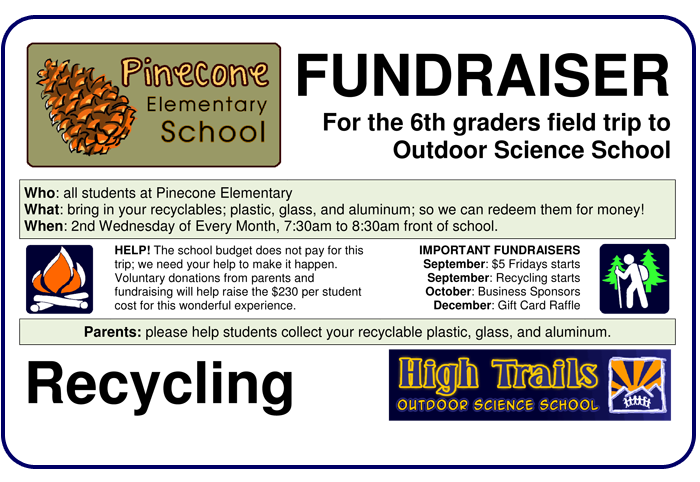
Regular Updates and Information
Do you want people to be involved in fundraising? Do you want them to care? The teachers decide that the best tactic here is to have weekly classroom announcements and monthly updates for both your classroom and your parents.
- Weekly Classroom Updates: once a week the teachers make general announcements and include the Outdoor Science School preparation in their agenda. They remind the students of the fundraising activities and encourage them to talk with their parents about the upcoming field trip. It may seem like a lot, but it only takes the teachers 3-4 minutes a week to keep their students excited about High Trails.
- Monthly Financial Goal Updates: once a month Teacher Two puts together an update for where the school stands with fundraising. She puts this on a flyer and sends it home with all of the students. Keep the parents informed and they are more likely to help with the cause.
 Be Patient: the first year of a fundraiser might go slowly, largely because you don’t yet have much momentum. It’s a new thing for the school and it will take some time to get it established and known within the community. You can address this lack of momentum by being patient and by giving constant updates and communicating effectively with parents and students.
Be Patient: the first year of a fundraiser might go slowly, largely because you don’t yet have much momentum. It’s a new thing for the school and it will take some time to get it established and known within the community. You can address this lack of momentum by being patient and by giving constant updates and communicating effectively with parents and students.
 Thank You Letters: start out right on this one; everytime someone helps you with field trip preparation, from a parent volunteer to a corporate donor, have your students write a “Thank You” letter. Not only will this ensure that you have supporters in the future, but you’ll also be teaching your students a valuable life lesson.
Thank You Letters: start out right on this one; everytime someone helps you with field trip preparation, from a parent volunteer to a corporate donor, have your students write a “Thank You” letter. Not only will this ensure that you have supporters in the future, but you’ll also be teaching your students a valuable life lesson.
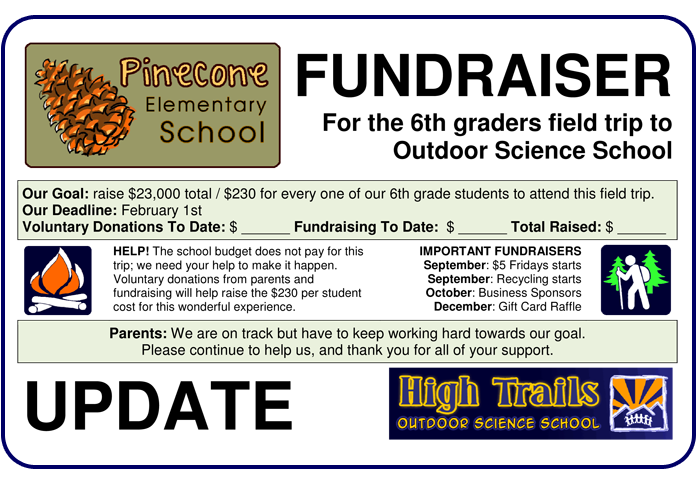
October
Fundraiser: Grants
Facing reality and the lack of time in their schedule, the teachers decide to put off writing any grants for now. Perhaps in spring there will be some time and they can apply to some grants for the next school year.
Short Term Fundraiser: Business Sponsors
The teachers want to jump on the Business Sponsors Fundraiser, as it doesn’t take a whole lot of time and offers some good potential returns. The general plan: offer local businesses advertising on T-Shirts that all of their students will wear around the local community. In return they donate money to the cause. Teacher Two takes on the job and gets busy.
- T-Shirts Design and Source: the teachers decide to put their school logo on the front of the T-Shirt and have the sponsors on the back. Teacher Two does some research on the internet and finds some options for T-Shirts.
-
- Online Option: the teachers found several online T-Shirt shops, several of which offered easy to use websites. They priced out 100 full color T-Shirts and it came to around $10 per shirt. If they wanted only one side printed it would cost about $5 per shirt.
- Local Option: it would be nice to give some business to a local business (after all, this is who you’re hitting up for some donations). Teacher Two, unfortunately, doesn’t find a T-Shirt printer anywhere near their school.
- Big Bear Option: High Trails goes through a fair amount of T-Shirts every year and has a good supplier. Bad Bear Sportswear, a Big Bear small business, can print white T-Shirts with a 2 color small logo on front and a 2 color sponsor spread on the back for about $8 a shirt. If they wanted only one side printed it would cost about $5 per shirt. High Trails would be a sponsor for the T-Shirt (their logo is on the back…). Because of this, High Trails will pickup the T-Shirts from Bad Bear Sportswear and deliver them to the students while they are at Outdoor Science School (this saves on shipping charges)! The cost for the T-Shirts is just added on to the school’s invoice from High Trails.
- Write an Advertising Sponsor Letter: Teacher Two works on a letter that will be used to send out and deliver to local businesses. Once she feels like she’s got it down, she moves on to the businesses themselves.
- List of Businesses: the teachers all write down 10 local businesses that they feel their students and parents patronize on a regular basis. Once they have this starter list Teacher Two talks with their principal, office manager, parent volunteers, students, and the phone book to build the list up to 50 businesses. She feels the best prospects will be businesses near the school, businesses that students and parents shop at a on a regular basis, and businesses that are firm supporters and employers of the community. Local restaurants, banks, and auto repair shops are good places to target. Once there are 50 businesses, Teacher Two makes a list of the businesses, addresses, and phone numbers. Then she brings in a parent volunteer to help with the next step.
- First Contact Businesses by Mail: Teacher Two asks a parent volunteer to call all 50 businesses on the phone. The goal is to get the name of the manager or contact person that can make decisions to sponsor their local elementary school. Once the names are determined, the parent volunteer uses the address list to personalize and mail out the Business Sponsor letter.
- Second Contact Businesses in Person: the teachers are really lucky and their parent volunteers are willing to help. They head out, students with them, and manage to personally visit 25 of the businesses on the list, stating their case and request in person. Any kind of follow up to a mailed letter is great!
- Third Contact by Phone: as the sponsor deadline approaches, Teacher Two spends some recesses in her classroom and listens as several of her students call up the local businesses. They ask for the contact person, introduce themselves, and then politely ask if the business will be supporting their local elementary school in their upcoming field trip.
- Prepare T-Shirt Design: as sponsorships come in, Teacher Two makes certain that the logos from the businesses are in the correct format and puts them all together. The T-Shirt company needs the files in a photoshop (.psd) or high quality jpeg file; fortunately Teacher Two knows a little bit about these graphics programs. If she didn’t know how to do it and couldn’t find anyone else to help, she could always contact High Trails; they would be glad to assist. Here’s what her design looks like for a front and back color printed T-Shirt:
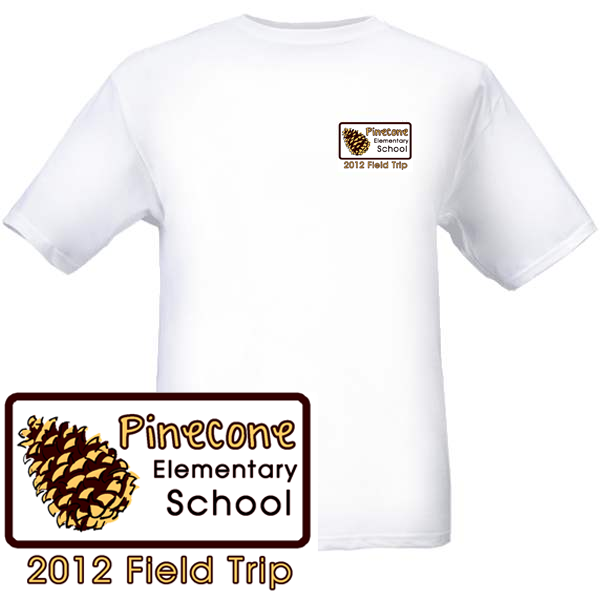
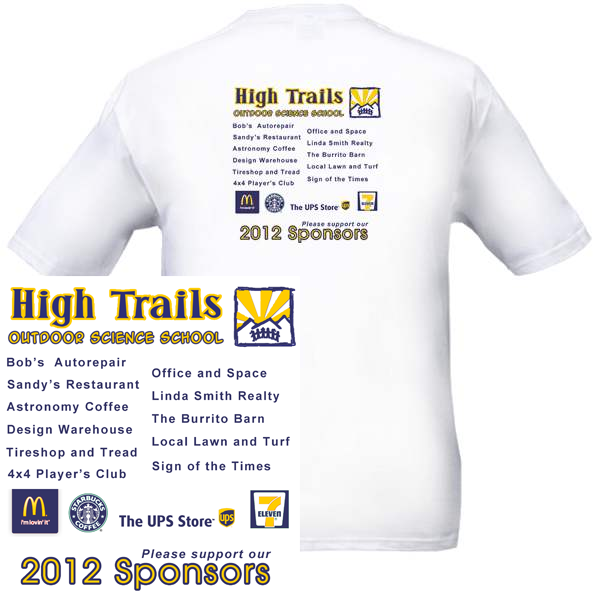
- Deadline T-Shirts: once the sponsorship deadline has passed and no more sponsorships show up, Teacher Two takes all of the information and emails it over to the T-Shirt company, along with a detailed list of the number and size of shirts needed. The goal is to have the T-Shirts delivered before the students go on their field trip. As soon as the T-Shirts show up, each student and teacher gets a free T-Shirt to wear around town; the advertisments paid for the entire process.
- Thank You Letters: before the field trip each business is sent a Thank You letter from Teacher Two’s classroom. They work hard to make sure the letter looks nice enough for the business to hang it on the wall for their customers to see.
 The Hardest Step is the First One: as with all of these fundraisers, the hardest time will be the first time you do them. After this, all of your work is there and ready for the next year’s go round. Console yourself that the work you do this first year to set up fundraisers can be handed down year to year for future teachers and students, and that work in the future is greatly reduced because of this initial work.
The Hardest Step is the First One: as with all of these fundraisers, the hardest time will be the first time you do them. After this, all of your work is there and ready for the next year’s go round. Console yourself that the work you do this first year to set up fundraisers can be handed down year to year for future teachers and students, and that work in the future is greatly reduced because of this initial work.

Pinecone Elementary sends sponsorship letters to 50 local businesses. 11 businesses sponsored one student each; 3 businesses sponsored two students each, and 1 business just wrote a check for $1,000. Total gained from this fundraiser = $4,910 – $800 (cost of shirts) for a profit of $4,210.
 Use PayPal: if you set up a PayPal account, you will be able to accept payments over the internet, and you will even be able to accept credit card payments (helpful with business sponsors). The easier you make it for people to donate, the more, and the more often, they will.
Use PayPal: if you set up a PayPal account, you will be able to accept payments over the internet, and you will even be able to accept credit card payments (helpful with business sponsors). The easier you make it for people to donate, the more, and the more often, they will.
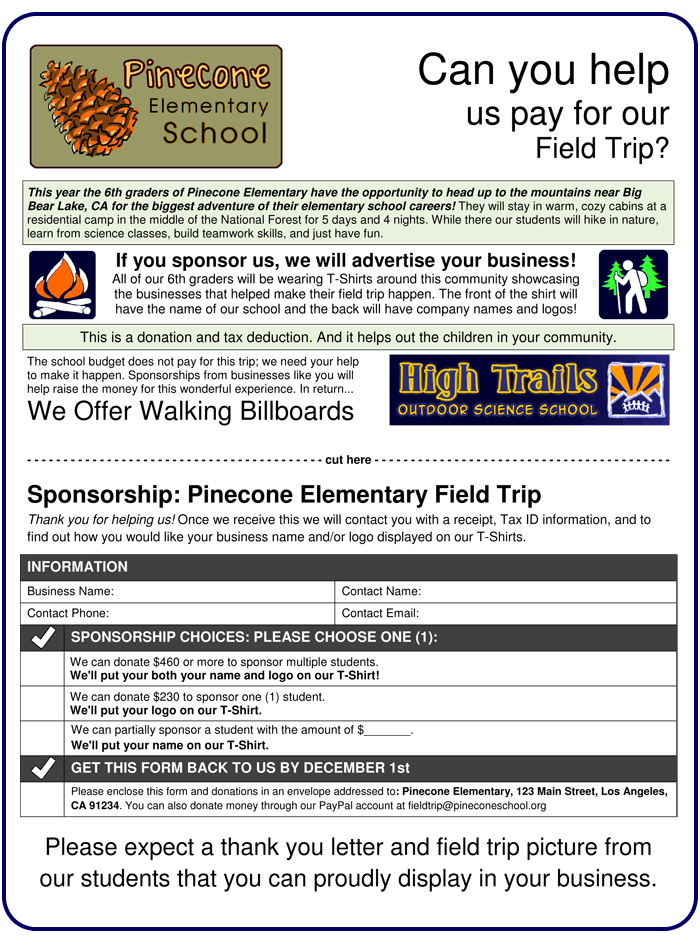
November
Nothing
Between Veteran’s Day and Thanksgiving, the month of November seems short. The teachers support the current fundraisers, but other than this, they just focus on teaching.

Know your limits. If you don’t have the time to put on a great fundraiser, the outcome will be affected. If you are pressed for time with school, chances are the rest of your teaching team and students are pressed for time also.
December
Short Term Fundraiser: Gift Card Raffle
Business sponsors and family donations are great, but the Teachers want to make certain that their students are helping out too; it’s important for them to realize that their efforts will directly affect their trip. The Gift Card Raffle is a great way to get them involved in selling raffle tickets to friends, neighbors, relatives, and more. The raffle tickets are just $1, but the overall prize is $300+ in various gift cards!
- Who’s In Charge? Teacher One jumps in on this fundraiser. She starts out by talking with the other teachers and coming up with a good event for the raffle; they decide on the 6th grade Holiday Performance the last week of school in December.
- Get Raffle Tickets: head down to the local office supply store and purchase a role of raffle tickets. With these tickets students can keep one half of the ticket and give the raffle ticket buyer the other half.
- Announcements to Parents and Students: Teacher One makes a flyer with all of the Gift Card Raffle information and gives copies to the other teachers. They announce it in class and send home the flyers the week before Thanksgiving Break. As the days lead up, all three of the teachers make daily announcements in class.
- Start the Sales: next step is to give the tickets to students so they can start to sell. The teachers start out by giving 5 raffle tickets to each student along with the announcement flyer. Once they sell their first five tickets and return the stubs and money, the teachers give them another 5 raffle tickets. This limits the amount of money that students might be carrying around and keeps everyone accountable. The teachers continue to encourage sales of raffle tickets all the way up to the night of the drawing.
- Buy the Gift Cards: collect $5 from each student to purchase a variety of gift cards (restaurants, clothing stores, supermarkets, entertainment) that will be raffled off to ONE lucky winner. The fine print: Once a student has sold $5 worth of raffle tickets, return their original donation to their “Individual Field Trip Fund”.
- Pull a Winner: on the night of the performance, Teacher One takes all of the raffle tickets, and in front of the crowd, draws a winner and rewards them with their prize.

Pinecone students start selling raffle tickets the week before Thanksgiving, and continue through the holiday and onto the December performance and drawing. The teachers decide to offer in class rewards and treats for the students that are doing well with the fundraising. 65 students brought in $5 each to purchase the gift cards, so the prize ended up being $325. The students sold 1,457 raffle tickets, so the Gift Card Raffle brought them $1,457 closer to their field trip.
 CA Raffle Laws: non-profits like elementary schools can hold raffles legally in California. Make sure that at least 90% of your raffle revenue goes directly to the charitable cause; if students bring in money to purchase gift cards you will avoid having to worry about this condition. If your school is not exempt from registration, you may have to pay $20 to the state of CA. See more here: http://ag.ca.gov/charities/raffles.php
CA Raffle Laws: non-profits like elementary schools can hold raffles legally in California. Make sure that at least 90% of your raffle revenue goes directly to the charitable cause; if students bring in money to purchase gift cards you will avoid having to worry about this condition. If your school is not exempt from registration, you may have to pay $20 to the state of CA. See more here: http://ag.ca.gov/charities/raffles.php
 Monthly Update to Parents: while monthly updates are important, updates at key times are imperative. Make sure you send out an update/reminder to parents before large school breaks like the December Holiday break.
Monthly Update to Parents: while monthly updates are important, updates at key times are imperative. Make sure you send out an update/reminder to parents before large school breaks like the December Holiday break.
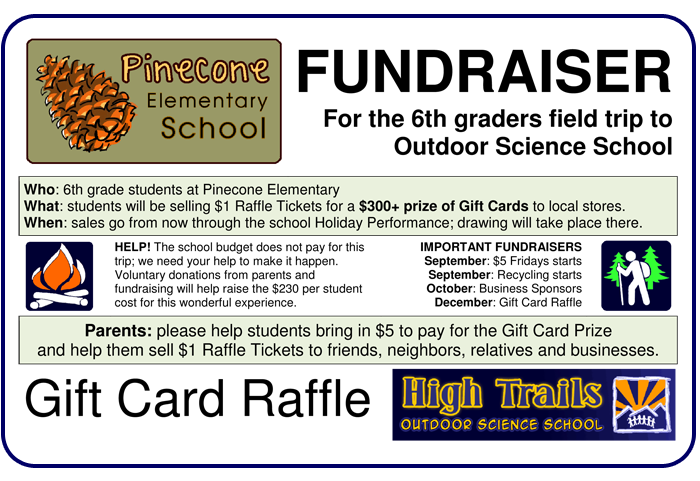
January
Financial Goal Check In
With 5 weeks until their Outdoor Science School Field Trip, the teachers sit down and do a thorough assessment of where they are at with fundraising. Doing this now will give them an idea of what they have to do over the next 5 weeks to make things happen for their students.
PINECONE ELEMENTARY: $$ GOALS VERSUS REALITY
50% will come from Voluntary Donations
Goal = $11,500 Reality = $11,000
• Voluntary Donations from parents of attending students brought in $11,000.
25% will come from Voluntary Fundraisers
Goal = $5,750 Reality = $13,267
• $5 Fridays has brought in $5,600
• Recycling brought in $2,000
• Business Sponsors brought in $4,210
• Gift Card Raffle brought in $1,457
25% will come from Grants
Goal = $5,750 Reality = $0
• Grants brought in $0
Overall Goal = $23,000 Reality = $24,267
Given that there are 5 weeks to go, Pinecone is looking pretty good with fundraising. The teachers decide to remind the parents about Voluntary Donations (there are still quite a few families that have not donated yet) and push forward with Recycling and $5 Friday Fundraisers. The extra money can go into the Field Trip fund for the next school year.
February
Final Results
In years past, this is where the teachers would look over the individual amounts collected per student and make sure each student had brought in enough money to pay for their field trip. CA AB 165 forces a change of plan, and the teachers are reminded that they cannot require any student to pay for this field trip. This doesn’t mean that they cannot ask for voluntary donations, given that they are truly voluntary. Again, be upfront and honest with your parents. “Johnny has $85 in his Individual Field Trip Fund right now. Can you, or another relative, donate more money to his account?”.
By phrasing this request as a question, the teachers are signifying that it is acceptable to answer both “yes” or “no”. When Johnny’s parents say “no, we can’t afford anything right now” the teachers are ready, and respond by saying “we don’t require a fee for this field trip; Johnny is invited to attend whether or not you donate any money to his fund”. The combination of many parents voluntarily donating the entire amount and the successful fundraisers has created a buffer that that the teachers can use to make certain all students attend High Trails. The teachers take a look at their final results and feel pretty good about what’s happened over the course of their fundraisers. They did it, with room to spare. Last step is to get an invoice from High Trails, turn it into their school office manager, and start to pack for their field trip. Whew.
PINECONE ELEMENTARY: FINAL FINANCIAL RESULTS
• Voluntary Donations = $11,800
• Voluntary Fundraisers = $13,450
• Grants = $0
Total Amount Raised = $25,250
Pinecone raised more than they needed. The additional money will be rolled over in their school account to be used for the next year’s field trip.
Keep High Trails in the Loop:
March
Review Successes and Failures
Now that their field trip is over, the teachers are ready to forget all about fundraising for a while. They decide to have a brief meeting, though, just to go over their successes and failures and make sure they’re ready for next year. Doing it now while everything is fresh in their minds will make it easier in the future.
Open Enrollment
As April approaches, the teachers start to get email reminders from High Trails about signing up for the next school year, starting on April 1st. The teachers meet, pick dates, and then Teacher One hops online and fills out the High Trails Enrollment Form. There will be a whole new class of students come next year….
